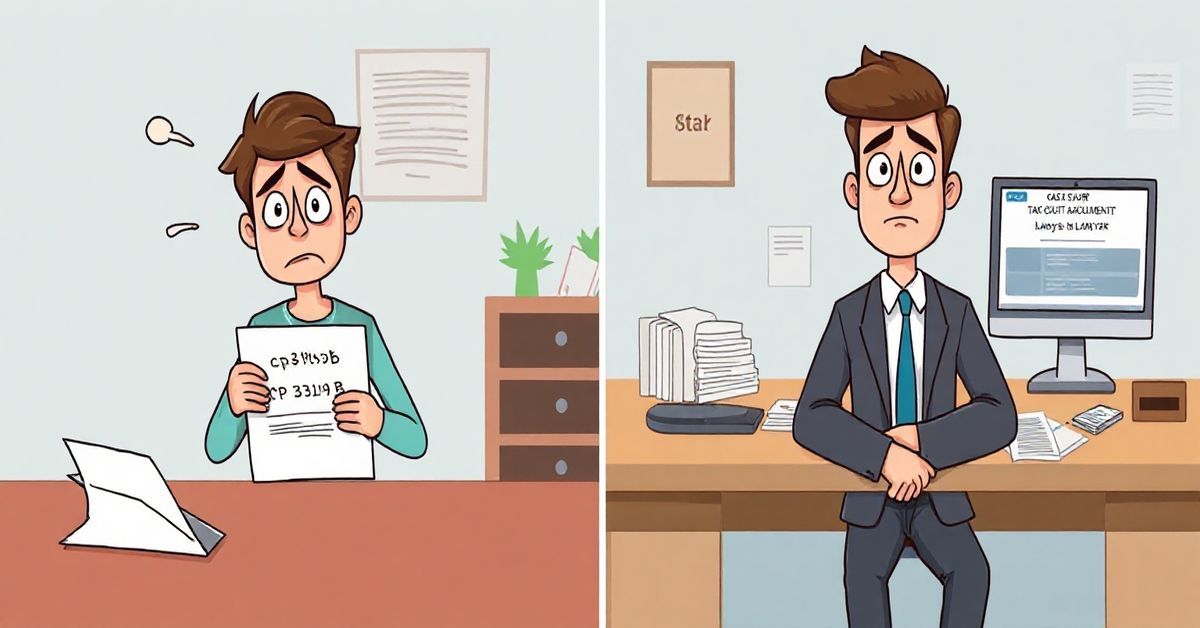Understanding the CP3219B Notice: Your Right to Challenge IRS Tax Claims
Receiving mail from the IRS can be nerve-wracking. When that mail contains a CP3219B Notice, it’s especially important to pay attention. This isn’t just a casual inquiry; it’s a formal notice that the IRS believes you owe more taxes and that they are beginning the formal process of collecting that debt. But here’s the good news: this notice also gives you a powerful tool – the right to take your case to the U.S. Tax Court. Let’s break down what this all means.
What Exactly Is a Notice of Deficiency?
The CP3219B Notice is often called a “Notice of Deficiency.” It is the IRS’s way of officially telling you that they believe there is a tax deficiency in your tax return. In other words, they think you owe more taxes than you reported. This notice outlines the reasons behind their assessment. The IRS doesn’t send this notice out of the blue. It usually follows an audit or examination of your tax return. Once they’ve reviewed your return, and believe more taxes are owed, you’ll get the CP3219B.
Key Points About a Notice of Deficiency:
- Formal Notification: It’s not a casual letter. It’s a legal document that starts the clock for certain rights and actions.
- Proposed Tax Due: It states the amount of additional tax, penalties, and interest the IRS believes you owe.
- Right to Petition: Most importantly, it informs you of your right to challenge the assessment in U.S. Tax Court.
- Specific Time Frame: You have a strict timeframe to respond. Generally, it’s 90 days from the date on the notice if you live in the US, and 150 days if you live outside the US.
Why Did I Get a CP3219B Notice?
There are several reasons you might receive this notice. Here are some of the most common:
- Disagreements over Deductions or Credits: The IRS might disagree with deductions or tax credits you claimed on your tax return. Perhaps they think you weren’t eligible or that you didn’t properly document them.
- Income Discrepancies: If the IRS believes you underreported your income, either from your job, self-employment, or investments, they might issue a Notice of Deficiency.
- Incorrect Tax Filing Status: Claiming the wrong filing status can lead to tax discrepancies. The IRS might correct it, leading to a tax deficiency.
- Mathematical Errors: If there are significant errors in your tax return calculations, the IRS might correct them and issue a Notice of Deficiency.
- Audit Findings: Following an audit, the IRS might issue a Notice of Deficiency if the auditor concludes you owe more.
Your Right to Petition the Tax Court
This is perhaps the most important aspect of the CP3219B Notice. It gives you the right to dispute the proposed deficiency by taking your case to the United States Tax Court. This is a very important and powerful right. You can challenge the IRS’s assessment in an independent court system before you have to pay the tax.
How to Petition the Tax Court:
- Read the Notice Carefully: Make sure you understand the reasons for the proposed deficiency. The notice contains important details.
- Act Quickly: You have a limited time, generally 90 days from the date of the notice (150 days if you are outside of the US), to file your petition with the U.S. Tax Court. Missing this deadline can mean losing your right to a Tax Court hearing.
- Prepare a Petition: The petition needs to explain why you believe the IRS is wrong. It needs to include specific details about your case and why you don’t agree with the tax deficiency.
- Submit Your Petition: You must submit your petition according to Tax Court rules. You’ll typically need to pay a filing fee, unless you qualify for a waiver. You will send this to the United States Tax Court in Washington, D.C.
What Happens After You Petition?
- Case Assignment: Your case is assigned to a Tax Court judge.
- IRS Response: The IRS will respond to your petition.
- Settlement Opportunities: The Tax Court will often encourage you and the IRS to attempt a settlement of your case. If successful, you can avoid a trial.
- Trial: If settlement isn’t possible, a trial will be scheduled. You will present evidence and argue your case. The IRS will do the same.
- Tax Court Decision: The Tax Court judge will issue a decision on your case. You or the IRS can appeal that decision to the Federal Court of Appeals.
What Happens if I Don’t Respond?
If you fail to respond to the CP3219B Notice within the designated timeframe, the IRS can proceed with assessing and collecting the tax deficiency. This might include liens on your property, wage garnishments, or levies on your bank accounts. Ignoring this notice is a costly mistake.
Should I Hire a Tax Professional?
Dealing with a Notice of Deficiency and Tax Court litigation can be complicated. It’s often best to seek professional help from a qualified tax professional such as a tax attorney, CPA, or enrolled agent. They can:
- Review Your Case: Assess the validity of the IRS’s claims and help you decide the best course of action.
- Help Prepare the Tax Court Petition: Ensure all relevant information is included in the petition.
- Negotiate with the IRS: Represent you in settlement discussions, potentially avoiding a trial.
- Represent You in Tax Court: Present your case and advocate on your behalf at a trial.
Important Tips for Dealing With a CP3219B Notice
- Don’t Panic: Stay calm. Receiving this notice is not the end of the world.
- Read Carefully: Thoroughly review the notice and understand the reasons for the proposed deficiency.
- Don’t Ignore It: Failing to act will result in the IRS taking action to collect the debt.
- Keep Records: Collect all related documents for your case, such as prior tax returns, receipts, invoices, proof of payments, etc.
- Act Quickly: The deadlines for responding are very important.
- Consider Professional Help: If you find the situation difficult or complex, hiring a professional can be a worthwhile investment.
Common Misconceptions About the Notice
- It Means You’re a Criminal: Getting a Notice of Deficiency doesn’t mean you have committed any crimes. It means the IRS believes there’s a tax deficiency they need to resolve.
- It Means You Have to Pay Immediately: You do not have to pay the amount right away. You can dispute it in court.
- You Can’t Win Against the IRS: This isn’t true. Taxpayers successfully challenge the IRS all the time. With proper representation and evidence, you can potentially reduce or eliminate the proposed tax deficiency.
In Summary
The CP3219B Notice is a serious communication from the IRS that needs to be dealt with promptly and carefully. However, it also provides you with an important right – the right to take your case to the Tax Court. Understand your options, don’t delay responding, and seek professional help if needed. By taking the appropriate steps, you can navigate this process with greater confidence.

